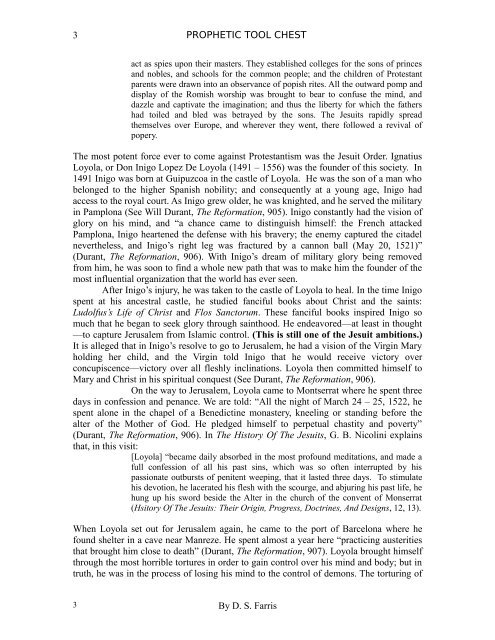CHAPTER SEVEN - Prophetic Toolchest
CHAPTER SEVEN - Prophetic Toolchest
CHAPTER SEVEN - Prophetic Toolchest
You also want an ePaper? Increase the reach of your titles
YUMPU automatically turns print PDFs into web optimized ePapers that Google loves.
3<br />
PROPHETIC TOOL CHEST<br />
act as spies upon their masters. They established colleges for the sons of princes<br />
and nobles, and schools for the common people; and the children of Protestant<br />
parents were drawn into an observance of popish rites. All the outward pomp and<br />
display of the Romish worship was brought to bear to confuse the mind, and<br />
dazzle and captivate the imagination; and thus the liberty for which the fathers<br />
had toiled and bled was betrayed by the sons. The Jesuits rapidly spread<br />
themselves over Europe, and wherever they went, there followed a revival of<br />
popery.<br />
The most potent force ever to come against Protestantism was the Jesuit Order. Ignatius<br />
Loyola, or Don Inigo Lopez De Loyola (1491 – 1556) was the founder of this society. In<br />
1491 Inigo was born at Guipuzcoa in the castle of Loyola. He was the son of a man who<br />
belonged to the higher Spanish nobility; and consequently at a young age, Inigo had<br />
access to the royal court. As Inigo grew older, he was knighted, and he served the military<br />
in Pamplona (See Will Durant, The Reformation, 905). Inigo constantly had the vision of<br />
glory on his mind, and “a chance came to distinguish himself: the French attacked<br />
Pamplona, Inigo heartened the defense with his bravery; the enemy captured the citadel<br />
nevertheless, and Inigo’s right leg was fractured by a cannon ball (May 20, 1521)”<br />
(Durant, The Reformation, 906). With Inigo’s dream of military glory being removed<br />
from him, he was soon to find a whole new path that was to make him the founder of the<br />
most influential organization that the world has ever seen.<br />
After Inigo’s injury, he was taken to the castle of Loyola to heal. In the time Inigo<br />
spent at his ancestral castle, he studied fanciful books about Christ and the saints:<br />
Ludolfus’s Life of Christ and Flos Sanctorum. These fanciful books inspired Inigo so<br />
much that he began to seek glory through sainthood. He endeavored—at least in thought<br />
—to capture Jerusalem from Islamic control. (This is still one of the Jesuit ambitions.)<br />
It is alleged that in Inigo’s resolve to go to Jerusalem, he had a vision of the Virgin Mary<br />
holding her child, and the Virgin told Inigo that he would receive victory over<br />
concupiscence—victory over all fleshly inclinations. Loyola then committed himself to<br />
Mary and Christ in his spiritual conquest (See Durant, The Reformation, 906).<br />
On the way to Jerusalem, Loyola came to Montserrat where he spent three<br />
days in confession and penance. We are told: “All the night of March 24 – 25, 1522, he<br />
spent alone in the chapel of a Benedictine monastery, kneeling or standing before the<br />
alter of the Mother of God. He pledged himself to perpetual chastity and poverty”<br />
(Durant, The Reformation, 906). In The History Of The Jesuits, G. B. Nicolini explains<br />
that, in this visit:<br />
[Loyola] “became daily absorbed in the most profound meditations, and made a<br />
full confession of all his past sins, which was so often interrupted by his<br />
passionate outbursts of penitent weeping, that it lasted three days. To stimulate<br />
his devotion, he lacerated his flesh with the scourge, and abjuring his past life, he<br />
hung up his sword beside the Alter in the church of the convent of Monserrat<br />
(Hsitory Of The Jesuits: Their Origin, Progress, Doctrines, And Designs, 12, 13).<br />
When Loyola set out for Jerusalem again, he came to the port of Barcelona where he<br />
found shelter in a cave near Manreze. He spent almost a year here “practicing austerities<br />
that brought him close to death” (Durant, The Reformation, 907). Loyola brought himself<br />
through the most horrible tortures in order to gain control over his mind and body; but in<br />
truth, he was in the process of losing his mind to the control of demons. The torturing of<br />
3<br />
By D. S. Farris


